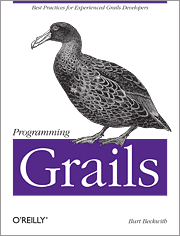Create your own Grails holder class
Sunday, November 13th, 2011I mentioned in an earlier post that using Grails
that using Grails *Holder classes should be avoided, and showed how to access the GrailsApplication, ApplicationContext, etc. from domain classes. But there are still cases where you need access to these objects and dependency injection and the approach I described aren’t sufficient. When all else fails you can always create your own holder class.
The reason this works in your application but not in Grails is that the static fields in your application are only accessed within your application. By using shared jars, multiple applications share static state held by shared classes, but this isn’t a problem for your code.
Since everything is reachable from the ApplicationContext and it’s easy to access, we’ll create a holder for that and expose the other objects from there.
Create a class called ApplicationContextHolder that implements ApplicationContextAware:
package com.yourcompany.yourapp
import org.springframework.context.ApplicationContext
import org.springframework.context.ApplicationContextAware
@Singleton
class ApplicationContextHolder implements ApplicationContextAware {
private ApplicationContext ctx
void setApplicationContext(ApplicationContext applicationContext) {
ctx = applicationContext
}
static ApplicationContext getApplicationContext() {
getInstance().ctx
}
}
and register it in resources.groovy so the ApplicationContext is injected (using the factoryMethod attribute since the class is a singleton):
import com.yourcompany.yourapp.ApplicationContextHolder
beans = {
applicationContextHolder(ApplicationContextHolder) { bean ->
bean.factoryMethod = 'getInstance'
}
}
Now you can use the ApplicationContext from anywhere to access Spring beans. We can go further though, adding utility methods to expose other classes held by holders:
static Object getBean(String name) {
getApplicationContext().getBean(name)
}
static GrailsApplication getGrailsApplication() {
getBean('grailsApplication')
}
static ConfigObject getConfig() {
getGrailsApplication().config
}
static ServletContext getServletContext() {
getBean('servletContext')
}
static GrailsPluginManager getPluginManager() {
getBean('pluginManager')
}
You can also add the ability to register mock beans for unit tests; here’s the complete class:
package com.yourcompany.yourapp
import org.springframework.context.ApplicationContext
import org.springframework.context.ApplicationContextAware
import javax.servlet.ServletContext
import org.codehaus.groovy.grails.commons.GrailsApplication
import org.codehaus.groovy.grails.plugins.GrailsPluginManager
import org.springframework.context.ApplicationContext
import org.springframework.context.ApplicationContextAware
@Singleton
class ApplicationContextHolder implements ApplicationContextAware {
private ApplicationContext ctx
private static final Map <String, Object> TEST_BEANS = [:]
void setApplicationContext(ApplicationContext applicationContext) {
ctx = applicationContext
}
static ApplicationContext getApplicationContext() {
getInstance().ctx
}
static Object getBean(String name) {
TEST_BEANS[name] ?: getApplicationContext().getBean(name)
}
static GrailsApplication getGrailsApplication() {
getBean('grailsApplication')
}
static ConfigObject getConfig() {
getGrailsApplication().config
}
static ServletContext getServletContext() {
getBean('servletContext')
}
static GrailsPluginManager getPluginManager() {
getBean('pluginManager')
}
// For testing
static void registerTestBean(String name, bean) {
TEST_BEANS[name] = bean
}
// For testing
static void unregisterTestBeans() {
TEST_BEANS.clear()
}
}
Note that the servletContext and pluginManager beans are available in a running application but not the Grails console.






